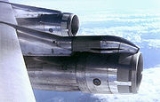
Podded engine
Encyclopedia
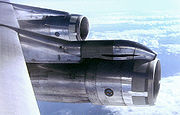
Nacelle
The nacelle is a cover housing that holds engines, fuel, or equipment on an aircraft. In some cases—for instance in the typical "Farman" type "pusher" aircraft, or the World War II-era P-38 Lightning—an aircraft's cockpit may also be housed in a nacelle, which essentially fills the...
.
Placing engines on the wing provides beneficial wing bending relief in flight. The further the engines are away from the fuselage
Fuselage
The fuselage is an aircraft's main body section that holds crew and passengers or cargo. In single-engine aircraft it will usually contain an engine, although in some amphibious aircraft the single engine is mounted on a pylon attached to the fuselage which in turn is used as a floating hull...
the greater the wing bending relief so engines buried in the wing root provide little relief. Almost all modern large jet airplanes use engines in pods located a significant distance from the wing root for substantial wing bending relief. The pods are in front of the wing to help avoid flutter of the wing which, in turn, allows a much lighter wing structure. Locating the pod below the wing provides each engine with air undisturbed by the fuselage
Fuselage
The fuselage is an aircraft's main body section that holds crew and passengers or cargo. In single-engine aircraft it will usually contain an engine, although in some amphibious aircraft the single engine is mounted on a pylon attached to the fuselage which in turn is used as a floating hull...
or wing. The wing also blocks some engine noise from reaching the aircraft cabin.
Fuselage-mounted podded engines
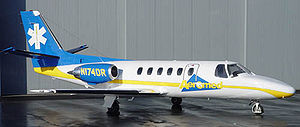
Cessna Citation
The Cessna Citation is a marketing name used by Cessna for its line of business jets. Rather than one particular model of aircraft, the name applies to several "families" of turbofan-powered aircraft that have been produced over the years...
are generally not suited to podded engines below the wing because they would be too close to the ground. This is also the case with aircraft designed to operate from unimproved grass or gravel runway
Runway
According to ICAO a runway is a "defined rectangular area on a land aerodrome prepared for the landing and take-off of aircraft." Runways may be a man-made surface or a natural surface .- Orientation and dimensions :Runways are named by a number between 01 and 36, which is generally one tenth...
s. Instead, in these cases it is common to mount two (or occasionally four) podded engines located at the rear of the fuselage
Fuselage
The fuselage is an aircraft's main body section that holds crew and passengers or cargo. In single-engine aircraft it will usually contain an engine, although in some amphibious aircraft the single engine is mounted on a pylon attached to the fuselage which in turn is used as a floating hull...
, where they are less likely to be damaged by ingesting foreign objects
Foreign object damage
Foreign Object Debris is a substance, debris or article alien to a vehicle or system which would potentially cause damage.Foreign Object Damage is any damage attributed to a foreign object that can be expressed in physical or economic terms that may or may not degrade the product's required...
from the ground.
This mounting location provides no wing bending relief but, following an engine failure, does offer much less yaw due to asymmetric thrust than would wing-mounted engines. Careful examination of such engines will show them typically mounted nose-high. These engines are mounted to face the local flow of air, and the local airflow at the airplane's tail is typically descending with respect to the centerline of the aircraft's fuselage
Fuselage
The fuselage is an aircraft's main body section that holds crew and passengers or cargo. In single-engine aircraft it will usually contain an engine, although in some amphibious aircraft the single engine is mounted on a pylon attached to the fuselage which in turn is used as a floating hull...
. However, it is now rare to see fuselage-mounted engines behind the wings on public airliners. This is partly a result of the investigation following the Scandinavian Airlines Flight 751
Scandinavian Airlines Flight 751
Scandinavian Airlines Flight 751 was a regularly scheduled Scandinavian Airlines flight from Stockholm, Sweden to Copenhagen, Denmark and Warsaw, Poland that crashed on 27 December 1991. The McDonnell Douglas MD-81 was piloted by Danish captain Stefan G. Rasmussen and Swedish first officer Ulf...
accident, when ice from the wings broke off and crushed both engines simultaneously in-flight.
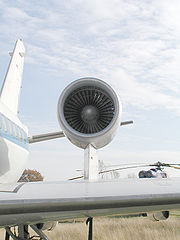
Overwing podded engines
As unusual counter-examples, the VFW-614VFW-614
-See also:-Bibliography:* Green, William. The Observer's Book of Aircraft. London. Frederick Warne & Co. Ltd., 1976. ISBN 0-7232-1553-7.* Jackson, Paul A. German Military Aviation 1956-1976. Hinckley, Leicestershire, UK: Midland Counties Publications, 1976. ISBN 0-904597-03-2.* Mellberg, Bill. "VFW...
and the Hondajet place the podded engines clear above the wings to maximize the distance between ground and engine and therefore minimize the likelihood of foreign object damage
Foreign object damage
Foreign Object Debris is a substance, debris or article alien to a vehicle or system which would potentially cause damage.Foreign Object Damage is any damage attributed to a foreign object that can be expressed in physical or economic terms that may or may not degrade the product's required...
.
The Antonov An-72
Antonov An-72
The Antonov An-72 is a transport aircraft developed by Antonov in the former Soviet Union. It was designed as a STOL transport and intended as a replacement for the Antonov An-26, but variants have found success as commercial freighters.The An-72 gets its nickname, Cheburashka, from the large...
and the Boeing YC-14
Boeing YC-14
The Boeing YC-14 was a twin-engine short take-off and landing tactical transport. It was Boeing's entrant into the United States Air Force's Advanced Medium STOL Transport competition, which aimed to replace the Lockheed C-130 Hercules as the USAF's standard STOL tactical transport...
also place their engines above the wings, but very close to the wing. This placement utilizes the Coandă effect
Coanda effect
The Coandă effect is the tendency of a fluid jet to be attracted to a nearby surface. The principle was named after Romanian aerodynamics pioneer Henri Coandă, who was the first to recognize the practical application of the phenomenon in aircraft development....
allowing a lower minimum flight speed and decreasing the amount of runway needed for takeoff and landing (i.e. STOL
STOL
STOL is an acronym for short take-off and landing, a term used to describe aircraft with very short runway requirements.-Definitions:There is no one accepted definition of STOL and many different definitions have been used by different authorities and nations at various times and for a myriad of...
).
Over fuselage podded engines
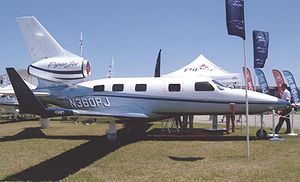

Heinkel He 162
The Heinkel He 162 Volksjäger was a German single-engine, jet-powered fighter aircraft fielded by the Luftwaffe in World War II. Designed and built quickly, and made primarily of wood as metals were in very short supply and prioritised for other aircraft, the He 162 was nevertheless the fastest of...
, and the Cirrus Vision SF50 are two examples. In both cases the idea is to mount the engine where it will get good air flow, be distant from the ground to avoid foreign object damage
Foreign object damage
Foreign Object Debris is a substance, debris or article alien to a vehicle or system which would potentially cause damage.Foreign Object Damage is any damage attributed to a foreign object that can be expressed in physical or economic terms that may or may not degrade the product's required...
, and not occupy fuselage space. The Piper PA-47 PiperJet
Piper PA-47 PiperJet
The Piper PA-47 PiperJet was a single-engined very light jet that was intended to be developed and built by Piper Aircraft. However, following a change of ownership at Piper, it was decided to redesign the aircraft into the PiperJet Altaire...
is similar except the pod is attached to the tail above the fuselage, and not to the fuselage itself.
Military aircraft
Some jet fighters use podded engines, typically under and mounted directly to the wing. Example include the Messerschmitt Me 262Messerschmitt Me 262
The Messerschmitt Me 262 Schwalbe was the world's first operational jet-powered fighter aircraft. Design work started before World War II began, but engine problems prevented the aircraft from attaining operational status with the Luftwaffe until mid-1944...
, the Mig 29, the Su-27, and the F-14 Tomcat
F-14 Tomcat
The Grumman F-14 Tomcat is a supersonic, twin-engine, two-seat, variable-sweep wing fighter aircraft. The Tomcat was developed for the United States Navy's Naval Fighter Experimental program following the collapse of the F-111B project...
. The A-10 Thunderbolt II
A-10 Thunderbolt II
The Fairchild Republic A-10 Thunderbolt II is an American single-seat, twin-engine, straight-wing jet aircraft developed by Fairchild-Republic in the early 1970s. The A-10 was designed for a United States Air Force requirement to provide close air support for ground forces by attacking tanks,...
ground-attack aircraft uses fuselage-mounted podded turbofan engines. The Heinkel He 162
Heinkel He 162
The Heinkel He 162 Volksjäger was a German single-engine, jet-powered fighter aircraft fielded by the Luftwaffe in World War II. Designed and built quickly, and made primarily of wood as metals were in very short supply and prioritised for other aircraft, the He 162 was nevertheless the fastest of...
had a single jet in a pod mounted over the fuselage.
Stealthy designs do not use podded engines. Instead the engines are contained within the fuselage to minimize radar cross section
Radar cross section
Radar cross section is a measure of how detectable an object is with a radar. A larger RCS indicates that an object is more easily detected.An object reflects a limited amount of radar energy...
.
Many military transport aircraft
Military transport aircraft
Military transport aircraft are typically fixed and rotary wing cargo aircraft which are used to deliver troops, weapons and other military equipment by a variety of methods to any area of military operations around the surface of the planet, usually outside of the commercial flight routes in...
, bomber
Bomber
A bomber is a military aircraft designed to attack ground and sea targets, by dropping bombs on them, or – in recent years – by launching cruise missiles at them.-Classifications of bombers:...
s, and tanker
Aerial refueling
Aerial refueling, also called air refueling, in-flight refueling , air-to-air refueling or tanking, is the process of transferring fuel from one aircraft to another during flight....
s use podded engines.
Advantages
Podded engines...- on the wings can act as vortex generatorVortex generatorA vortex generator is an aerodynamic surface, consisting of a small vane or bump that creates a vortex. Vortex generators can be found on many devices, but the term is most often used in aircraft design....
s. - can be located significantly outboard on the wing, where the wing thickness is too small to accommodate a buried engine. The further outboard, the greater the wing bending relief.
- in front of the wing provide maximum resistance to flutter of the wing. This is why almost all of the engine pod is located ahead of the leading edge of the wing.
- ease maintenance access.
- reduce noise within the cabin (since the engines are farther from the cabin, and for engines mounted below the wing, the wing itself acts as a noise shield).
- can often be exchanged with alternative models more easily. For example, the Boeing 747Boeing 747The Boeing 747 is a wide-body commercial airliner and cargo transport, often referred to by its original nickname, Jumbo Jet, or Queen of the Skies. It is among the world's most recognizable aircraft, and was the first wide-body ever produced...
uses engines from GEGE-AviationGE Aviation, a subsidiary of General Electric, is headquartered in Evendale, Ohio . GE Aviation is the top supplier of aircraft engines in the world, and offers engines for the majority of commercial aircraft. GE Aviation is part of the General Electric conglomerate, which is one of the world's...
, Pratt and Whitney, and Rolls RoyceRolls-Royce plcRolls-Royce Group plc is a global power systems company headquartered in the City of Westminster, London, United Kingdom. It is the world’s second-largest maker of aircraft engines , and also has major businesses in the marine propulsion and energy sectors. Through its defence-related activities...
, the changes being mostly isolated to the pods themselves. - are less likely to critically damage the aircraft than an engine embedded within the airframe if they explode, catch fire or break free from their mounts. Although such events seldom happen to modern jet engines, this possibility helps explain why podded engines are commonly used on commercial and general aviationGeneral aviationGeneral aviation is one of the two categories of civil aviation. It refers to all flights other than military and scheduled airline and regular cargo flights, both private and commercial. General aviation flights range from gliders and powered parachutes to large, non-scheduled cargo jet flights...
aircraft that may carry fare-paying passengers. Military combat jets are often occupied only by crew members who can bail outParachuteA parachute is a device used to slow the motion of an object through an atmosphere by creating drag, or in the case of ram-air parachutes, aerodynamic lift. Parachutes are usually made out of light, strong cloth, originally silk, now most commonly nylon...
of the craft in an emergency, making this safety factor less crucial.
Disadvantages
- Podded engines can increase drag.
- A podded engine hanging low from a wing can suffer more damage from foreign object damageForeign object damageForeign Object Debris is a substance, debris or article alien to a vehicle or system which would potentially cause damage.Foreign Object Damage is any damage attributed to a foreign object that can be expressed in physical or economic terms that may or may not degrade the product's required...
. - In a ditching or water landingWater landingA water landing is, in the broadest sense, any landing on a body of water. All waterfowl, those seabirds capable of flight, and some human-built vehicles are capable of landing in water as a matter of course....
, podded engines hanging from the wing increase the stress on the wing by increasing the amount of drag caused by the water. This can cause the wings to shear off or flip the aircraft and destroy the fuselage as happened to Ethiopian Airlines Flight 961Ethiopian Airlines Flight 961Ethiopian Airlines Flight 961, a Boeing 767-260ER, was hijacked on , en route from Addis Ababa to Nairobi on a Bombay–Addis Ababa–Nairobi–Brazzaville–Lagos–Abidjan service, by three Ethiopians seeking political asylum in Australia. The plane crash-landed in the Indian Ocean near Comoros due to fuel...
.

